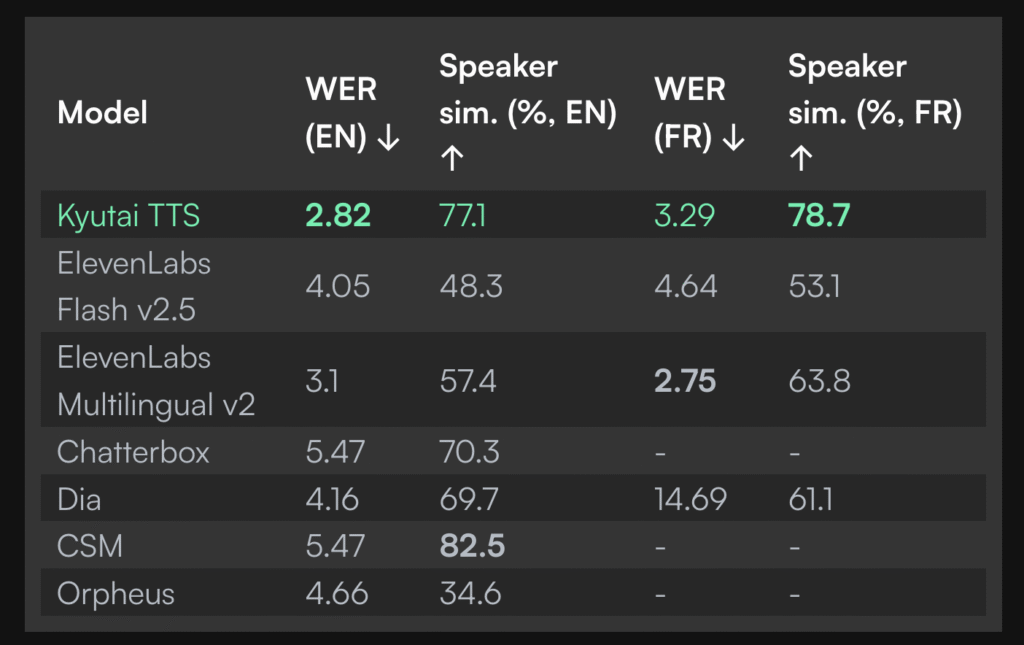Kyutai, an open AI research lab, has released a groundbreaking streaming Text-to-Speech (TTS) model with ~2 billion parameters. Designed for real-time responsiveness, this model delivers ultra-low latency audio generation (220 milliseconds) while maintaining high fidelity. It’s trained on an unprecedented 2.5 million hours of audio and is licensed under the permissive CC-BY-4.0, reinforcing Kyutai’s commitment to openness and reproducibility. This advancement redefines the efficiency and accessibility of large-scale speech generation models, particularly for edge deployment and agentic AI.
Unpacking the Performance: Sub-350ms Latency for 32 Concurrent Users on a Single L40 GPU
The model’s streaming capability is its most distinctive feature. On a single NVIDIA L40 GPU, the system can serve up to 32 concurrent users while keeping the latency under 350ms. For individual use, the model maintains a generation latency as low as 220ms, enabling nearly real-time applications such as conversational agents, voice assistants, and live narration systems. This performance is enabled through Kyutai’s novel Delayed Streams Modeling approach, which allows the model to generate speech incrementally as text arrives.
Key Technical Metrics:
- Model size: ~2B parameters
- Training data: 2.5 million hours of speech
- Latency: 220ms single-user,
- Language support: English and French
- License: CC-BY-4.0 (open source)
Delayed Streams Modeling: Architecting Real-Time Responsiveness
Kyutai’s innovation is anchored in Delayed Streams Modeling, a technique that allows speech synthesis to begin before the full input text is available. This approach is specifically designed to balance prediction quality with response speed, enabling high-throughput streaming TTS. Unlike conventional autoregressive models that suffer from response lag, this architecture maintains temporal coherence while achieving faster-than-real-time synthesis.
The codebase and training recipe for this architecture are available at Kyutai’s GitHub repository, supporting full reproducibility and community contributions.
Model Availability and Open Research Commitment
Kyutai has released the model weights and inference scripts on Hugging Face, making it accessible for researchers, developers, and commercial teams. The permissive CC-BY-4.0 license encourages unrestricted adaptation and integration into applications, provided proper attribution is maintained.
This release supports both batch and streaming inference, making it a versatile foundation for voice cloning, real-time chatbots, accessibility tools, and more. With pretrained models in both English and French, Kyutai sets the stage for multilingual TTS pipelines.
Implications for Real-Time AI Applications
By reducing the speech generation latency to the 200ms range, Kyutai’s model narrows the human-perceptible delay between intent and speech, making it viable for:
- Conversational AI: Human-like voice interfaces with low turnaround
- Assistive Tech: Faster screen readers and voice feedback systems
- Media Production: Voiceovers with rapid iteration cycles
- Edge Devices: Optimized inference for low-power or on-device environments
The ability to serve 32 users on a single L40 GPU without quality degradation also makes it attractive for scaling speech services efficiently in cloud environments.
Conclusion: Open, Fast, and Ready for Deployment
Kyutai’s streaming TTS release is a milestone in speech AI. With high-quality synthesis, real-time latency, and generous licensing, it addresses critical needs for both researchers and real-world product teams. The model’s reproducibility, multilingual support, and scalable performance make it a standout alternative to proprietary solutions.
For more details, you can explore the official model card on Hugging Face, technical explanation on Kyutai’s site, and implementation specifics on GitHub.
Sana Hassan, a consulting intern at Marktechpost and dual-degree student at IIT Madras, is passionate about applying technology and AI to address real-world challenges. With a keen interest in solving practical problems, he brings a fresh perspective to the intersection of AI and real-life solutions.



